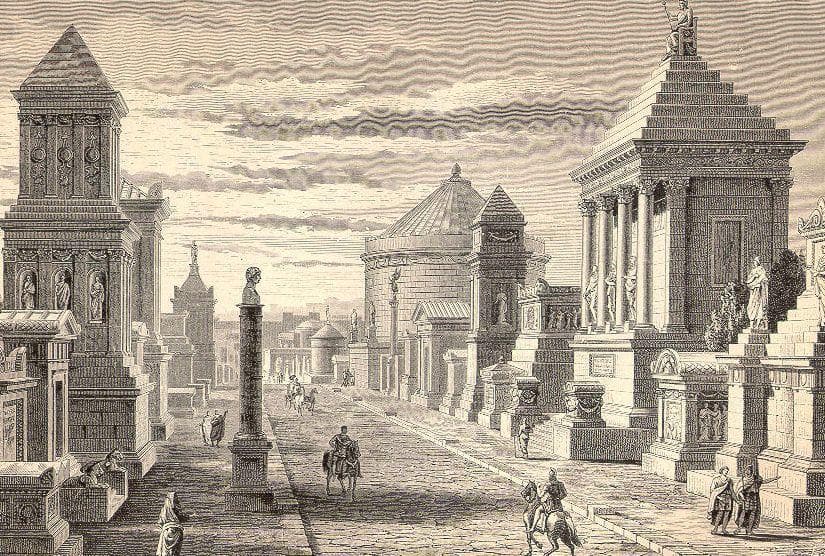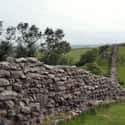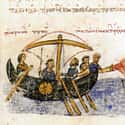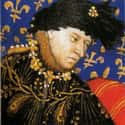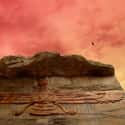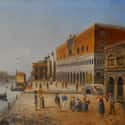-
(#4) The Wall Has An Ancient Roman Counterpart In Hadrian’s Wall
The most obvious historical parallel in A Song of Ice and Fire is also the one that inspired the entire series. While the Romans didn’t have the technology to erect a towering wall of ice like the one along the northern border of Westeros, they did build Hadrian’s Wall across 73 miles of northern Britain.
Hadrian’s Wall was intended to keep out those the Romans saw as barbarians - Picts, in this case, instead of Wildlings. Just as the Wall marks the northernmost reach of Westerosi authority, Hadrian’s Wall was also seen as a marker of the Roman Empire’s upper limit. There was no analog to the Night’s Watch tasked with manning Hadrian’s Wall, though; it was just staffed by the Roman legions.
As George R.R. Martin tells it, his first inklings of the story that would become A Song of Ice and Fire began with a visit to Hadrian’s Wall:
The Wall predates anything else. I can trace back the inspiration for that to 1981. I was in England visiting a friend, and as we approached the border of England and Scotland, we stopped to see Hadrian’s Wall. I stood up there and I tried to imagine what it was like to be a Roman legionary, standing on this wall, looking at these distant hills. It was a very profound feeling. For the Romans at that time, this was the end of civilization; it was the end of the world. We know that there were Scots beyond the hills, but they didn’t know that. It could have been any kind of monster. It was the sense of this barrier against dark forces - it planted something in me. But when you write fantasy, everything is bigger and more colorful, so I took the Wall and made it three times as long and 700 feet high, and made it out of ice.
-
(#9) The Battle Of Blackwater Bay Follows The Plot Of The Second Arab Siege Of Constantinople
The conflict at Blackwater Bay closes the second season of Game of Thrones and remains one of the most epic moments in the series. Some viewers might have felt the fiery action stretched the bounds of the show’s semi-medieval setting, but things actually went down a lot like the Second Arab Siege of Constantinople.
Both conflicts featured a naval strike against a city that sat on a bay, with Constantinople protected by the Golden Horn. The Turks didn’t have access to the fictional wildfire, but they did have Greek fire, an incendiary substance that was thrown at enemy ships with great success. The bay at Constantinople was also protected by a great chain, which is the same defense Tyrion Lannister uses to turn the tide against Stannis Baratheon's fleet.
-
(#13) Charles VI of France
- Notable Figure
In many ways, the conflict in Game of Thrones stems from the actions of the generation that preceded its main cast, and their troubles were largely caused by the Mad King, Aerys Targaryen. Aerys’s slaying of Rickard and Brandon Stark - and his subsequent demand for the heads of Ned Stark and Robert Baratheon - sparked Robert’s Rebellion, and his actions were the result of his slow descent into madness.
There have been many mad monarchs in history, but the one with the clearest correlation to Aerys seems to be King Charles VI, also known as Charles the Mad. Like Aerys, Charles began to slip into insanity and frequent bouts of aggression as a result of his increasing paranoia. Unlike the fictional Targaryen, the French king’s paranoia stemmed from a condition that caused him to think his entire body was made of glass.
-
(#6) Zoroastrianism
- Religion
The faiths of Westeros are many, but none are as controversial as the worship of R’hllor practiced by Red Priests and Priestesses, like Melisandre. The tenets of the Lord of Light might read like something out of a fantasy series, but they borrow a lot from Zoroastrianism, one of the earliest monotheistic religions in human history.
Both faiths focus heavily on the importance of fire and an understanding of the universe as divided into binary terms. The Zoroastrians also have a hero-figure who is destined to take on the forces of evil in a climactic fight, but theirs is named Ahura Mazda instead of Azor Ahai, proving this isn't a complete copy-and-paste job.
-
(#8) The Ironborn Are The Vikings Of Westeros
While the main conflict in Game of Thrones is based on the 15th-century conflicts of Europe, it isn’t tied to any particular time period. That allows George R.R. Martin to mix history up a little bit, bringing together historical concepts and figures that actually existed centuries apart. The Ironborn are a great example of this.
As a culture based entirely around reaping and pillaging, the Ironborn are clearly inspired by the Vikings, but the Norse sailed the seas hundreds of years before the Yorks and Lancasters began fighting. By bringing the vicious Greyjoys into conflict with the Starks and Lannisters, Martin gets to mash together historical empires that never had the chance to clash in real life.
-
(#7) The Braavosi Are Basically Venetians
The fictional city of Braavos may be located across the sea from Westeros, but it plays a major role in Game of Thrones. Most notably, it's where Arya learns the art of face-swapping and fighting. The infrastructure of Braavos is dominated by canals, which makes it pretty obviously inspired by the real-life city of Venice. But there’s more to the connection than waterways.
Like Venice, Braavos operates as an independent city-state. Whereas the politics of Braavos are dominated by the Iron Bank and the mysterious guild of the Faceless Men, Venice was ruled for centuries by a similarly nebulous group called the Council of Ten.
New Random Displays Display All By Ranking
About This Tool
When George RR Martin created a highly detailed fantasy medieval world, most of the content of "Game of Thrones" based on medieval European history. It is certain that Martin drew a lot of historical details from the "War of the Roses", which between the Lancaster family and the York family for the throne of England from 1455 to 1485 AD. They are the two descendants of the King Edward III of the Gorse dynasty.
There are many plots in "Game Of Thrones" that have real historical parallels in medieval times. The random tool lists 15 details about the historical events that are similar to "Game Of Thrones".
Our data comes from Ranker, If you want to participate in the ranking of items displayed on this page, please click here.

